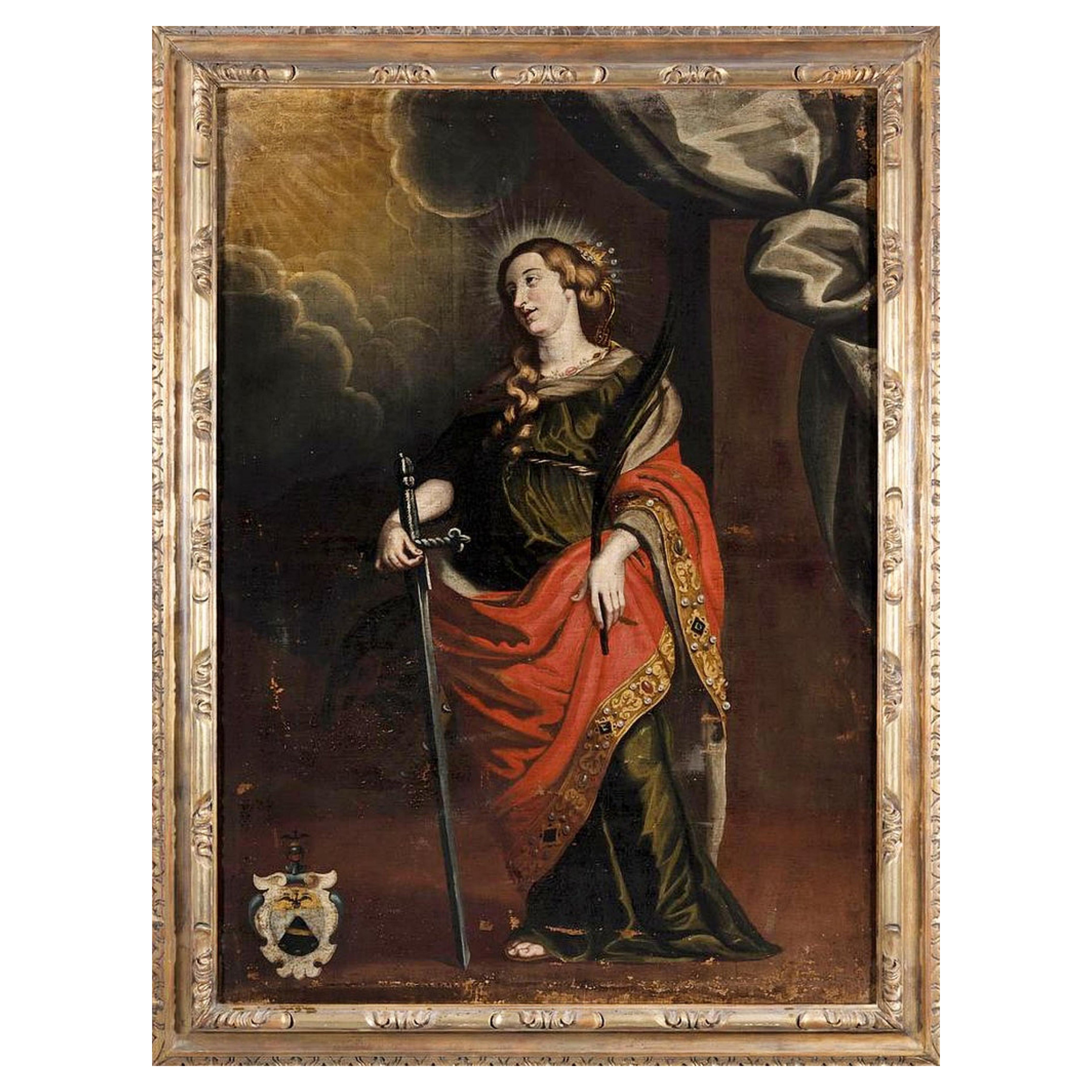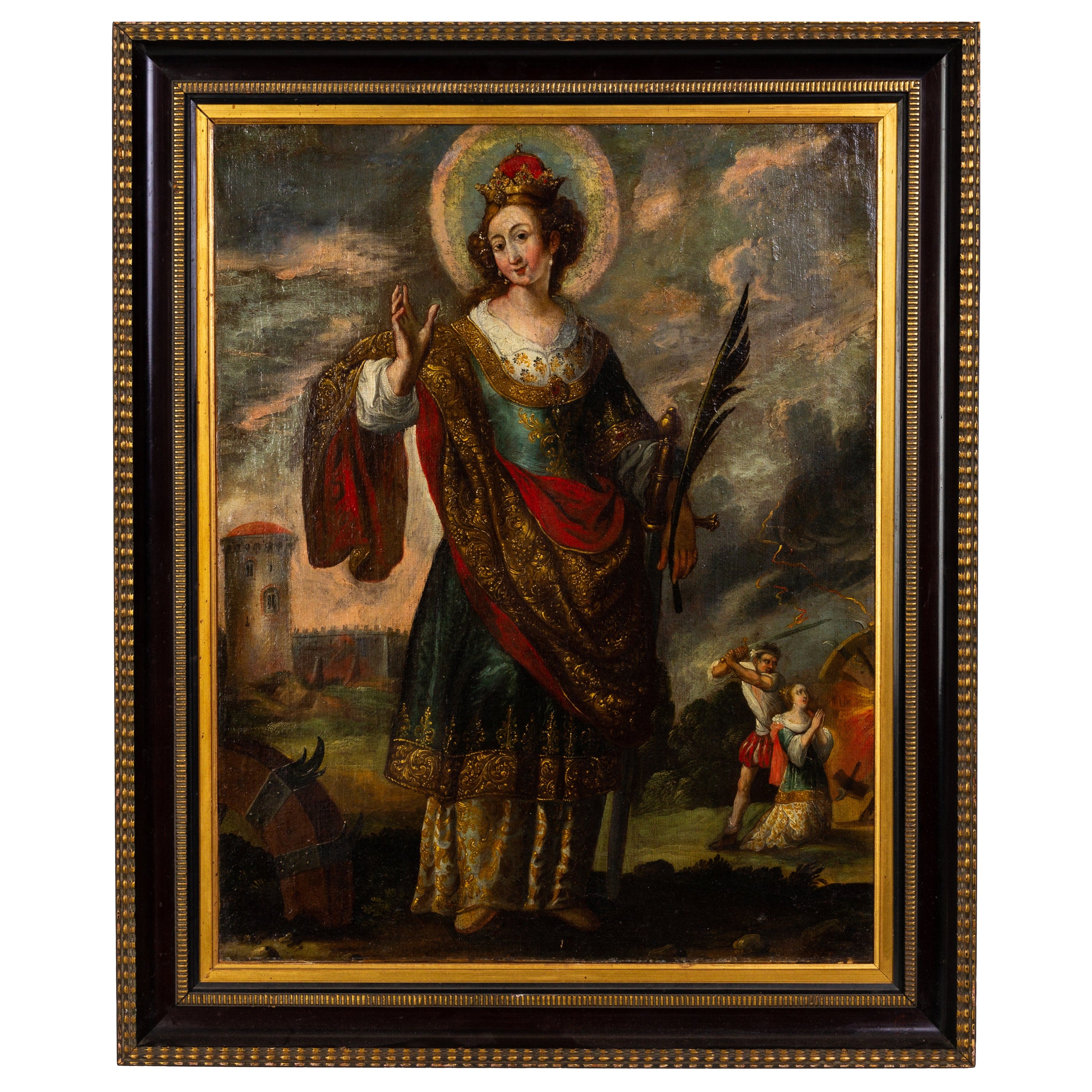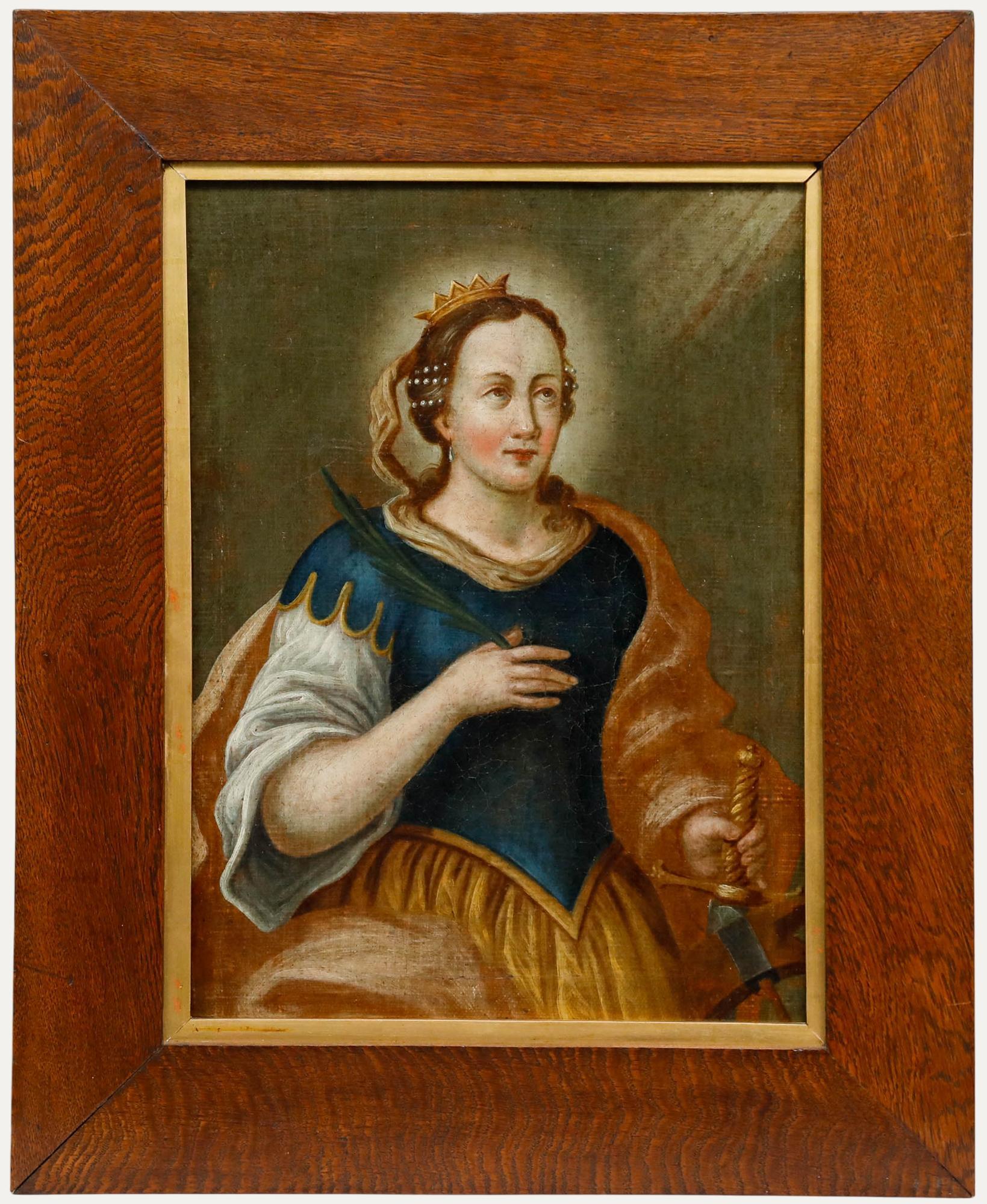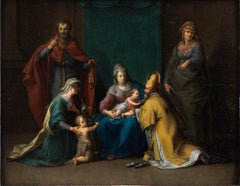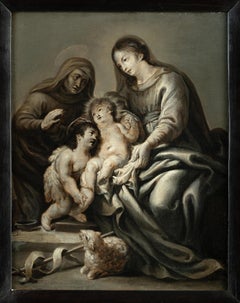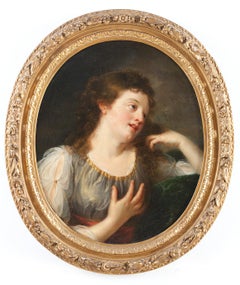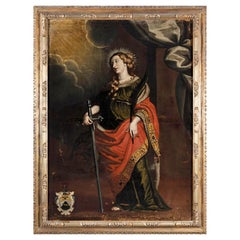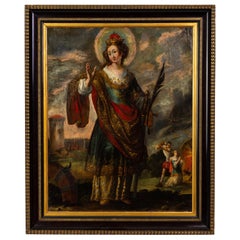Items Similar to Boeckhorst, Rubens, Saint Ursula, Decorative Old Master, Woman, Baroque, Flemish
Video Loading
Want more images or videos?
Request additional images or videos from the seller
1 of 10
Jan BoeckhorstBoeckhorst, Rubens, Saint Ursula, Decorative Old Master, Woman, Baroque, Flemishc. 1645
c. 1645
$53,531.38
$71,375.1725% Off
£39,657.33
£52,876.4425% Off
€45,000
€60,00025% Off
CA$73,629.31
CA$98,172.4125% Off
A$81,896.91
A$109,195.8825% Off
CHF 42,963
CHF 57,28425% Off
MX$999,328.35
MX$1,332,437.8025% Off
NOK 539,239.95
NOK 718,986.6025% Off
SEK 508,168.25
SEK 677,557.6725% Off
DKK 342,624.06
DKK 456,832.0925% Off
About the Item
Johann Boeckhorst (Münster 1604 - Antwerp 1668)
Saint Ursula
Oil on canvas, 112 x 86 cm
Provenance:
New York, Christe's, 20.3.1981, lot 88 (as Van Diepenbeeck's circle)
The present painting has only recently been rediscovered. It was not known in the art historical literature, nor had it ever been exhibited in public before. It is an important work by Johann Boeckhorst, which he created in his middle creative phase.
It depicts St. Ursula with the ten thousand virgins. Ursula is said to have lived between 300 and 400 AD as the daughter of a Christian king. She committed herself to eternal virginity, but was betrothed by her father to the pagan King Aetherius of England. She agreed under certain conditions. Within three years, Aetherius was to be taught Christianity and baptized. She herself wanted to make a pilgrimage to Rome with ten companions and 11,000 virgins. The journey took them across the North Sea and the Rhine through Cologne and Basel and from there on foot to Rome. In Cologne, an angel appeared to her in a dream, foretelling her coming martyrdom. On the return journey from Rome, the pilgrims were attacked by the Huns in Cologne. The king of the Huns coveted Ursula. As she refused him, she was shot with an arrow and her companions murdered.
Johann Boeckhorst was one of the most successful successors to the famous Baroque painters Peter Paul Rubens and Anthonis van Dyck. He came from an old Münster family. The second of a total of twelve children, Johann Boeckhorst was born in Münster between 1603 and 1605. At first, it seemed as if he, like his other siblings, would enter ecclesiastical or political service. However, he was the only one of his family to opt for an artistic career. He moved to Antwerp in the middle of the Thirty Years' War. This city was then one of the centers of the Counter-Reformation and the most important and influential Baroque artists were based there. In Antwerp, Johann Boeckhorst trained as a painter under a master unknown to us today. He soon became a freelance master and was employed by the important Rubens workshop. He maintained friendly contacts with famous painters of his time such as Frans Snyders, Anthonis van Dyck and Jan Wildens. He worked on the most important commissions of the time, such as the entry of Cardinal Ferdinand into Antwerp, the so-called Pompa Introitus and the decoration of the Torre de la Parada hunting lodge near Madrid. He also created paintings and large picture cycles for the Antwerp art market, for churches and for wealthy citizens of the city. His success grew after the death of the great masters Rubens and Van Dyck. He followed in their footsteps with other artists of his generation. He enjoyed an exemplary reputation as a painter of history paintings and portraits in particular.
The formal language of this painting is reminiscent of other depictions of female saints, such as Saint Helena (Antwerp) and Saint Barbara (location unknown). The virtuoso rendering of the materiality is particularly impressive and is reminiscent of paintings such as King David (Ghent/Greenville). Technically, it shows Boeckhorst's typical composition of a grayish ground on which the decorative elements, such as the cloak, were then placed. The work is made to be seen from a distance; the shiny parts of the robe and the jewelry only really come into their own at a greater distance. It can be assumed that this painting was created for a church interior and was perhaps part of a series of depictions of saints.
- Creator:Jan Boeckhorst (1604 - 1668, German)
- Creation Year:c. 1645
- Dimensions:Height: 44.1 in (112 cm)Width: 33.86 in (86 cm)
- Medium:
- Movement & Style:
- Period:
- Condition:
- Gallery Location:Greven, DE
- Reference Number:1stDibs: LU1550213461822
About the Seller
4.8
Gold Seller
Premium sellers maintaining a 4.3+ rating and 24-hour response times
Established in 2011
1stDibs seller since 2021
30 sales on 1stDibs
Typical response time: 1 hour
- ShippingRetrieving quote...Shipping from: Greven, Germany
- Return Policy
Authenticity Guarantee
In the unlikely event there’s an issue with an item’s authenticity, contact us within 1 year for a full refund. DetailsMoney-Back Guarantee
If your item is not as described, is damaged in transit, or does not arrive, contact us within 7 days for a full refund. Details24-Hour Cancellation
You have a 24-hour grace period in which to reconsider your purchase, with no questions asked.Vetted Professional Sellers
Our world-class sellers must adhere to strict standards for service and quality, maintaining the integrity of our listings.Price-Match Guarantee
If you find that a seller listed the same item for a lower price elsewhere, we’ll match it.Trusted Global Delivery
Our best-in-class carrier network provides specialized shipping options worldwide, including custom delivery.More From This Seller
View AllSacra Conversazione, Maria, Christ, Old Master, Religious, Baroque Painting, art
Located in Greven, DE
Attributed to Peter Candid / Pieter de Witte
(Bruges c. 1540 - 1628 Munich)
Sacra Conversazione
Oil on wood, 29 x 37 cm
The painter, sculptor and architect Peter Candid, known in Italy as Pietro Candido, was born in Bruges between 1540 and 1548. In the 1560s he stayed in Florence, where he worked in the workshop of Giorgio Vasari, with whom he collaborated on a number of commissions for the House of Medici. After a brief stay in Volterra, he went to Munich in 1586. For the next 42 years, until his death, he remained court painter to Duke William V...
Category
17th Century Renaissance Figurative Paintings
Materials
Oil, Panel
Old Master Painting, Flemish Baroque Grisaille, Cornelis Schut, Mary with Child
Located in Greven, DE
Cornelis Schut, atrributed to
(1597 - Antwerp - 1655)
Mary with Child, St. Elisabeth and John the Baptist en grisaille
Oil on wood, 33,5 x 26,5 cm
Co...
Category
17th Century Baroque Figurative Paintings
Materials
Oil
French School, Portrait of a Lady, Actress, Young Woman, French , Rococo, Oval
Located in Greven, DE
French Art
Rococo
Portrait of a Woman, Young Lady, perhaps an actress
Category
18th Century Rococo Figurative Paintings
Materials
Canvas
Baroque Italian Old Master, Madonna, Child, Angels, Oval, Marratta, Christmas
By Workshop Of Carlo Maratta
Located in Greven, DE
Religious Painting, depicting Madonna and the Child, surrounded by Angels by the Circle of Carlo Maratta (Maratti). This painting is wonderful example of...
Category
18th Century Baroque Figurative Paintings
Materials
Canvas, Oil
$19,033 Sale Price
20% Off
Fenzoni, Painting AND preparatorial Drawing, John the Baptist, Italy Renaissance
By Ferrau Fenzoni
Located in Greven, DE
The painting and the preparatory drawing are offered together.
Provenance
Private collection, Germany, Trier, c. 1980- 2013
Saint John the Baptist
Brown ink and wash over red chalk on oatmeal paper
31 x 20.5 cm
Inscribed: „Ferrau Fenzonio da Faenza invt. esque … imp. da Fran. Villamena …“.
bears the collector's mark of Henry Scipio Reitlinger (1882-1950; Lugt 2274a) on a tiny label glued to the verso
On the reverse is a partial drawing of a Pieta, pricked for transfer.
Provenance
New York, Doyle, 14. October 2015, No. 6
The painting and the preparatory drawing resemble the composition of an engraving after Ferraù Fenzoni by Francesco Villamena. Drawing, engraving and painting are almost identical, except for minor differences. Even the measurements nearly correspond: painting (32 x 25,5 cm), drawing (30 x 20,5 cm), engraving (31,1 x 23,5 cm).
Dr. Guiseppe Scavizzi confirmed the attribution of the present panting to Fenzoni and he dates it to c. 1590.
The inscription on the drawing reads “Ferrau Fenzonio da Faenza invt. esque. . . imp. da Fran: Villamena . . .”. The engraving’s inscription also lists place and date “Ferra Fensionius inventor/F. Villamoena sculpsit Rome/Aspectu fruitur… antra puer/cum Privilegio… 1613”.
Interestingly, the engraving is not mirrored as it is in most printing processes. Painting, drawing and engraving are not reversed but the same. It is remarkable to note that there are further paintings by Fenzoni which were engraved in the same order and not reverted. They also show strong parallels regarding the compositions and the measurements (see for example “Deposition of Christ” ).
Ferraù Fenzoni was an Italian painter mainly active in Todi. He is also called Il Faenzone after his birthplace (Faenza). He apprenticed in Rome during the papacy of Gregory XIII and contributed to numerous fresco cycles under pope Sixtus V, such as the Loggia della Benedizioni in the Lateran Palace, the frescoes on the walls and vaults of the Scala Santa of the adjacent Basilica of San Giovanni in Laterano, and the decoration in the Sistine library. His expressive canvases straddle the styles of Mannerism and Baroque. In 1594, he moved to Todi. A “Last Judgement” by him is housed in the cathedral of Todi. He returned to Faenza in 1599, where he decorated chapels in the cathedral from 1612 to 1616. In 1622, he completed a “Deposition”, now in the local Pinacoteca. In 1640, Fenzoni was named “cavaliere dello speron d’oro” by Cardinal Colonna and, on 25th April 1634, he was nominated vicar and “castellano of Granarolo”.
Fenzoni‘s style is characterized by a mixture of the Mannerism of the Northern Netherlands and the Italian Baroque.
Saint John the Baptist, Old Master, 17th Century, By Fenzoni, Religious Scene, Rome Art...
Category
16th Century Mannerist Figurative Paintings
Materials
Canvas, Oil, Handmade Paper
Ferrau FenzoniFenzoni, Painting AND preparatorial Drawing, John the Baptist, Italy Renaissance, 1590
$28,550 Sale Price
25% Off
Flemish 17th, Orpheus and Animals, Large Decorative Wall Old Master Painting
Located in Greven, DE
Flemish school, 17th century
Orpheus and the animals
Oil on canvas, 146,5 x 217 cm
Provenance: South German private collection.
On an impressive, room-filling format, this painting depicts "Orpheus and the Animals."
The harp-playing Orpheus sits centrally in front of a tree whose trunk bifurcates above his head. This central tree frames with its crown the scenery towards the horizon and at the same time offers through branches the possibility for many birds to find space. The left half of the picture is characterized by a seascape, at the edge of which the ruins of a castle can be seen deep in the background. This seascape, framed by mountains on the horizon, is the only area where sky can be seen. On this side, waterfowl such as storks, swans and ducks can be seen. In the right half, the viewer looks into a deep European forest. On this right side, more land animals can be found, such as deer, rabbits and lions, among others. Orpheus wears opulent red and gold trimmed clothing, under his blue breastplate we see a white shirt. His feet are adorned by elaborate sandals. His head is surrounded by a radiant laurel wreath ("poeta laureatus"). The young man is clearly identifiable as the singer and poet of Greek mythology, Orpheus, by his harp, the laurel wreath and the animals surrounding him.
Orpheus was one of the Argonauts who, under Jason, was searching for the Golden Fleece. He sang so beautifully that he even conquered the angry sea and enemies by the magic of his lyre. During the journey, Orpheus is said to have drowned out even the sirens with his singing. It is said that he was the greatest of all poets and charmed people, animals, stones and trees with his singing.
In total, 51 birds and 37 different species are depicted in the painting. The animals are mostly depicted in great detail and, except for a few, can be identified. Mainly European species of animals are shown. Exceptions are the ostrich-like nandu peeking out from behind the deer, as well as the large parrot on the upper left, and the two lions. Similar is the case for the large animal directly behind Orpheus on the right. The shape of the head suggests an arctic fox from the polar regions, even though the body is much too large. The arctic fox was first described in 1555 by Olaus Magnus. However, it could also be a depiction of a brown or black bear.
An unusual detail is the animal, which is relatively isolated in the right background and looks to the left. It is not clearly identifiable, but it shows certain similarities with the Australian kangaroo. This was first described by Vespucci in 1500 and further by Francisco Pelsaert in 1629. If it is indeed a kangaroo, this would be one of the earliest surviving pictorial representations.
In this painting, Orpheus is accompanied by a small monkey playing a viola da gamba. This is an iconographic peculiarity. In general, this painting has some peculiarities compared to other paintings with "Orpheus and the animals". The central positioning of Orpheus is quite common, but he usually holds a lyre and is dressed in an antique style, but not as opulently. The choice of animals is also remarkable: European animals in particular are seen, hardly any exotic features, such as camels or elephants.
The two lions in the right foreground are a quotation from Peter Paul Rubens and his depiction of "Daniel in the Lion's Den", which was realized in an engraving.
The present painting can be classified as belonging to the Flemish School of the 17th century on the basis of its painterly and compositional conception. From the circle of Jan Brueghel the Younger are numerous representations of this Orpheus - theme, which take it as an opportunity to show as many exotic animals. There are also echoes of Spanish painters such as Juan de Arellano...
Category
17th Century Baroque Landscape Paintings
Materials
Canvas, Oil
You May Also Like
Peter Paul Rubens Circle of "Saint Catherine " Never Restored First Canvas
By Peter Paul Rubens
Located in Madrid, ES
Peter Paul Rubens (Siegen 1577 - Antwerp 1640) circle of
Saint Catherine of Alexandria
Never Restored First Canvas
Oil on canvas
129.5 x 94 cm
The work is based on the painting by Peter Paul Rubens and engraved by Schelte von Bolswert.
Rubens, known as "the Prince of the Baroque", was the great master who revolutionized both Flemish and European painting. His first training took place thanks to the masters Otto van Veen and Jan Brueghel the Elder. His trip to Italy, where he stayed, studied and painted for eight years, was fundamental to his artistic growth. His first stop was Venice, where Titian, Veronese and Tintoretto studied. He later came into contact with Vincenzo I Gonzaga, Duke of Mantua, becoming the court painter of the family, a position he held until the end of his stay in Italy. In Mantua, Rubens had the opportunity to study the rich ducal collection closely and assiduously. By making copies of several famous paintings he was able to practice technically on the examples of the greatest masters. In 1601 he was sent by the duke to Rome, where he was able to further broaden his figurative horizons thanks to the copying of the models of Michelangelo and Raphael and the study of the ancient, also looking at the contemporary artistic production of Carracci, Caravaggio and Federico Barocci. After leaving Italy, he settled in Antwerp, where he organized his atelier, applying the methods of organized production, that is, employing his collaborators with rational criteria and on the basis of individual specializations. Among the many painters who came out of Rubens' workshop or were strongly influenced by the master, we remember: Cornelis and Paul de Vos, Jacob Jordaens, Pieter Van Mol, Victor Wolvoet, Joanna Vergouwen, Jan Boeckhorst known as Lange Jan, Lucas Van Uden, Theodor Van Thulden, Peter Van Lint, Willem Van Harp, Vincent Adrianssen, Pieter Van Avont, Jan and Hendrick van Balen, Theodor Boeyemans or Boeijermans, Vincent Malò...
Category
Antique 17th Century German Baroque Paintings
Materials
Paint
$5,652 Sale Price
20% Off
Huge Saint Catherine of Alexandria 17th Century Old Master Portrait Oil Painting
Located in Nottingham, GB
Huge Saint Catherine of Alexandria 17th Century Old Master Portrait Oil Painting
Dimensions: 88cm x 73cm, framed.
Good condition overall,...
Category
Antique 17th Century Paintings
Materials
Canvas, Paint
From Paolo Veronese, Allegory of Strength and Wisdom
By Paolo Veronese
Located in Milan, IT
Follower of Paolo Veronese (Verona, 1528 - Venice, 1588)
Allegory of wisdom and strength
Oil on canvas, 48 x 36.5 cm
Picture frame, 61 x 48 cm
The Allegory of Wisdom and Strength...
Category
16th Century Other Art Style Figurative Paintings
Materials
Canvas, Oil
Early 19th Century Oil - Saint Barbara of Nicomedia
Located in Corsham, GB
A charming depiction of Saint Barbara, a Christian martyr and a symbol of courage and devotion in the face of adversity. She is also the patron saint of armourers, artillerymen, mili...
Category
Early 19th Century Portrait Paintings
Materials
Oil
Terwesten Woman Allegory Art Paint Oil on canvas 17/18th Century Old master
Located in Riva del Garda, IT
Mattheus Terwesten (The Hague, 1670 - 1757)
Portrait of a young woman with palette and brushes, as Allegory of the art of Painting
Oil on canvas
160 x 91 cm. - In frame 178 x 107 cm...
Category
17th Century Old Masters Paintings
Materials
Oil
$11,753 Sale Price
20% Off
Saint Catherine Religious Reni 17th Century Paint Oil on canvas Old master Italy
Located in Riva del Garda, IT
Guido Reni (Bologna 1575 - 1642) Workshop of
Probably Gian Domenico Cerrini, the Cavalier Perugino (Perugia 1609 - Rome 1681)
Saint Catherine of Alexandria Oil on canvas 65 x 5...
Category
17th Century Old Masters Paintings
Materials
Oil
$8,041 Sale Price
20% Off
More Ways To Browse
Flemish Masters
Large Baroque Frames
Old Master Flemish
Antique Flemish Frame
Flemish Portrait Painting
Flemish Baroque
After Rubens
Baroque Oil Painting Large
Saint Peter Painting
Oil Paintings Rubens
Rhine Art
New England Church Painting
Pilgrims Painting
Peter Paul Rubens
Sea Painting 17th Century
Saint Peter Oil
Baroque Painting Angel
Antique Baroque Picture Frames
